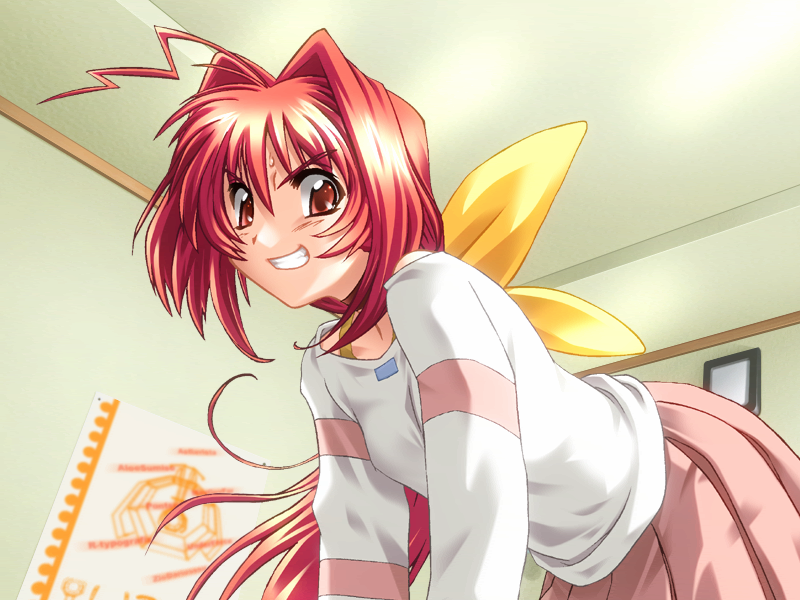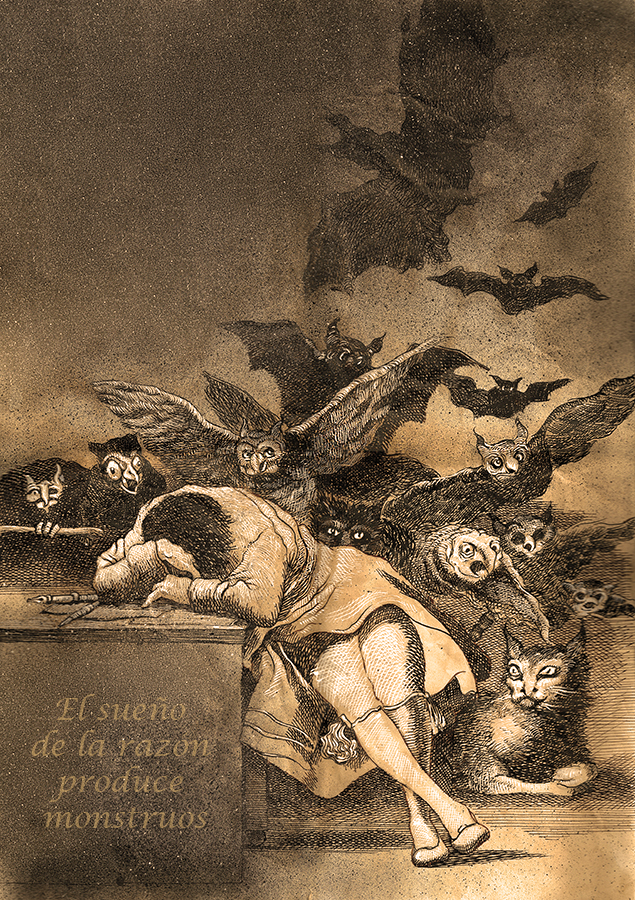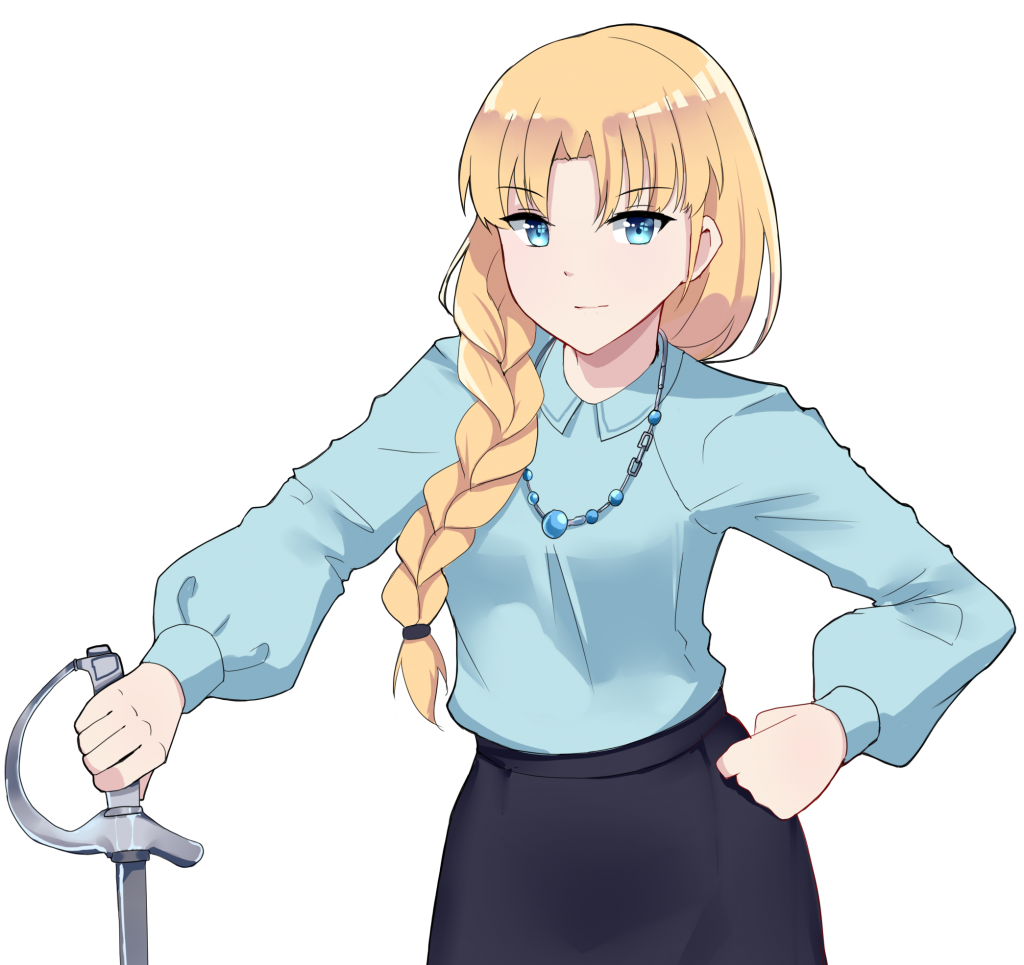Welcome to article number two of The Combat Report, the Steel Hearts developer blog, where I write about the conceptualization and development of our visual novel. Since I wrote about Lisabet last week, this article will focus on Juliet, one of the four heroines of Steel Hearts, who in some respects could be seen as a rival to Lisabet.
Minor character details may be “spoiled” ahead, but there are no major spoilers or other plot details that would ruin a first-time read of the VN.
Humble Beginnings
“You should really be more grateful to have girls like us around, you know!”
Annaliese Zimmer on her and Juliet
Juliet, unashamedly, fits well within the archetype of a “childhood friend”. It would be easy to assume then that Juliet was created to be the “primary” heroine, or at least was created first. However, this is not so–Juliet was created after the three other heroines were formulated (though, still early-on in the VN’s development). Then, she was called Julie, and she primarily was created to create a grounded point, an anchor, for both the protagonist and the reader. Caleb interacts with a number of strange characters, like the eccentric Lisabet, the stoic Hannah, and the confident and noble Brynhilde. To give both the player and Caleb a break in-between interactions with these oddballs, we created Juliet–Caleb’s long-time friend and next-door neighbor since 1931 (so, eight years).

Our good friend JTH created her initial design, which I then touched up to what you see here. Between her light chestnut-colored hair and her amber eyes, Juliet aims to be approachable, youthful, and innocent. And what of her glasses? I’ll get to that later. We thought the name “Juliet” would fit her girl-next-door nature, and it, of course, carried romantic connotations. Her last name, Träger, came from the German word tragen, which means to carry or support. Though we didn’t know it at the time, that name would become very, very appropriate.
Hey, I’ve Seen This One! This is a classic!
“Well… I’d just rather have you do it. An alarm clock’s just a little bit harsher than you.”
Caleb on Juliet waking him up
Well, now we have our character. What’s she like? As I said, Juliet is familiar. Like many of her archetype, she wakes the protagonist up. She cooks for the protagonist on occasion. She’s a bit of a ditz, but she tries hard to keep up in school. And as explained in the Lisabet article, she has implicit romantic feelings for the protagonist. Okay, to what end?
Most “childhood friend” characters you’ve seen are probably from modern-day Japan, a very peaceful and stable place. And, like many other characters of her archetype, Juliet is quite the bright, happy ray of sunshine. She however exists in a 1930’s Europe analogue–I don’t have to tell you how that’s a very tumultuous time. As the other heroines push their influence onto the world with their force of personality (even Lis to some extent), Juliet instead reacts to the pressure of the ever-changing world–a world that won’t stop and wait for her.

As other heroines face conflicts with other people or within themselves, Juliet instead bears the weight of the world upon her–in both her route and in the greater war story of the latter half of Steel Hearts, Juliet must stand firm in the face of the change, the loss, the pain, and the fears of a world that grows ever-darker. As the anchor of the reader and protagonist both, Juliet faces the danger of eroding away–or even sinking, lost to the depths.
Not so fun, right? Don’t you just want your normal, happy childhood friend back? What do you mean you don’t want Juliet to shake you up from your bedroll and cook you your Verpflegungssatz? If only you could go back to Weißwurst and pretzels!
All’s Fair…
“Why do things have to be this way?”
Juliet
Or, maybe it is fun. Contrast is one of my favorite tools, and one that I’ve used often in Steel Hearts. Take something familiar, and skew it (usually gradually) toward another, differing direction. [Don’t take this to mean ‘subversion’, which I see as pulling the rug out from the reader. Something like “Haha! Turns out Juliet was a crazy axe-murderer all along!” with no buildup, foreshadowing or reason beyond shocking the player.] I wrote about contrast a bit in Lisabet’s article, where I talked about some aspects of her beautiful, ladylike design contrasted with her misfit persona.
Juliet is not exempt from contrast, both small things and bigger things. Take, for example, her glasses. I’ve had many people assume Juliet is a bookish nerd, or librarian, or similar. It’s a reasonable assumption to make, but I think the contrast of Juliet’s glasses versus her somewhat unintelligent (at least academically) nature. But even then–Juliet has a vested interest in literature despite her academic deficiencies. A double layer of contrast?! How daring! More seriously, little things like this help flesh out a character–how many people do you know that act or look in opposition to how they might initially appear or seem? Quite a few, I imagine.

I apply the same principle of contrast to her greater character arc. The cheery, energetic girl-next-door bears a lot of sorrow on her back–and grows to bear even more. A story a bit more optimistic might fit her, (and it certainly wouldn’t be bad) but, again, contrast makes it all the more striking.
And, well, the sorrow wasn’t out of nowhere. You knew it was going to happen. Juliet doesn’t just wake Caleb up at the start of the VN. Juliet wakes Caleb up to go to the National Bloc’s “parade”, a show of the military’s new Panzerkampfläufer III Ausf. E walkers. It’s 1939? Wait a tic…
Don’t get me wrong–there’s plenty of fun times to be had with Juliet. Going out for ice cream, listening to radio shows, dunking Ms. Römisch at the school festival’s dunk tank, going to see a cheesy monster movie, and more. But when times get tough, don’t forget to support Juliet–she’ll support you, too. She’s tougher than she appears. And, when times get tough, don’t say we didn’t warn you.
Afterword
Thanks for reading! If you’re interested in Steel Hearts, feel free to follow this blog, or follow us on twitter at https://twitter.com/heartscorps.
Contact me at:
Twitter – https://twitter.com/PalladionHearts
Discord – Palladion#5914








